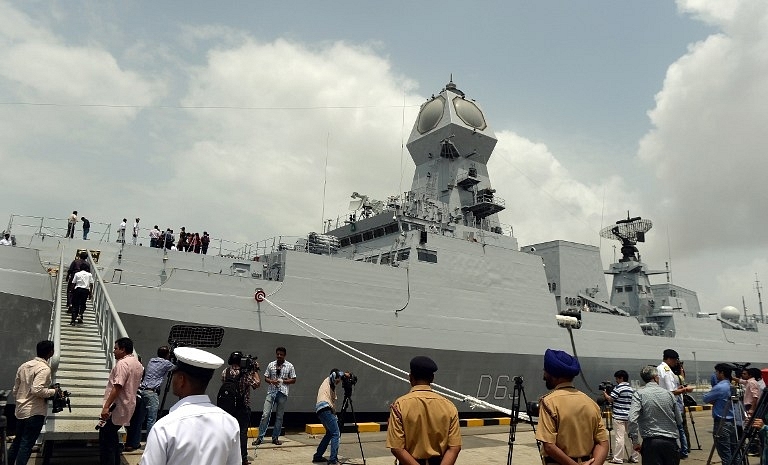Economy
Budget 2015: Financing India's Defence

Defence budgets are the best way to judge whether a government is putting its money where its mouth is, as also precisely which mouths it is putting money into. In that context defence allocations for 2015-16 show a clear trend towards a quickening naval buildup in the Indian Ocean Region (IOR) and push for faster border infrastructure, both of which dovetail with the strategic goal of pushing back China from India’s sphere of influence. However capital expenditure allocations for the Indian Air force (IAF), India’s most capital using service do not show any appreciable increase indicating that the government remains lukewarm to the Dassault Rafale proposal. The allocation for DRDO has remained more or less the same from last year, showing an increase in the revenue component and a decrease in the capital head, indicating that the government isn’t yet voting decisively in favour of ‘designed and developed in India’ as the main constituent of ‘Make in India’.
Nevertheless, the fact that money is also being made available for handholding industry R&D efforts is encouraging. Overall, despite the near 8 percent jump from the last budget, defence spend continues to languish at less than 2 percent of GDP and 13 percent of the total budgetary outlay for the year ahead i.e 2015-16.
The Indian Navy’s (IN’s) warship build plans are certainly being boosted with the budgeted capital outlay for ‘naval fleet’ in 2015-16 marking a 33 percent jump over the budget estimate for 2014-15 and a near 80 percent jump over the revised estimate for the same period. Clearly money is being forwarded for more naval platforms including India’s first indigenous aircraft carrier (IAC), INS Vikrant II under construction at Cochin Shipyard. In 2014, the Cabinet Committee on Security (CCS) gave the go ahead for Phase-2 of the IAC project that includes fitment of equipment on board the ship. The increased allocation for ‘naval fleet’ reflects that. It probably also reflects the commencement of a new seven ship stealth frigate build program. The thrust now is clearly towards establishing a pre-eminent naval posture in the IOR precluding the possibility of China someday leveraging its emerging commercial web in the region to threaten India from its south i.e from the seas.
Now even as India’s southern maritime domain is being strengthened, the push back against China’s salami slicing tactics along the Northern borders is also on display in this year’s budget. The capital outlay for Indian Army (IA) construction programmes, though marginally lower than the revised estimate for 2014-15, is higher than the budgetary allocation from the same period. Thus indicating a consistent desire to complete China centric projects such as new bases, ammunition stores and other staging infrastructure. Moreover the IA’s salary budget (easily more than the total equipment spend by the IN and IAF combined) has shown an increase of around Rs 5000 crores reflecting manpower accretions for new offensive formations meant for deployment on the China front.
However worries about the China front have not led to the government expediting the IAF proposal to purchase 126 Dassault Rafale fighters under the MMRCA program. The capital outlay for ‘Aircraft & Aero-engines’ for the IAF is only around Rs 18000 crores for 2014-16 and it is believed that a payment of Rs 15,000 crores would have to be made if any deal with Dassault is signed. Given the IAF’s on-going capital expenses, this means that there is as yet no deal with Dassault for the Rafale. Of course, if a deal were indeed to be made in the coming months it would probably get reflected in the revised estimates for 2015-16. Nevertheless it is interesting to note that the budgetary allocation made this year for aircraft and engines for the IAF is some 40 percent lower than the IAF’s actual spend under this head in 2013-14. Overall the IAF continues to be the heaviest spender on equipment but the IN is now slowly catching up. The IA of course continues to hog the overall budget on account of revenue expenditure but is number three on the capital side of things. In the years ahead the IA will have to completely indigenize its pool of equipment if it wants greater bang for buck.
For DRDO, this year’s budget is essentially neutral in that it more or less preserves the jump in allocation it received in the Modi government’s interim budget last year after years of stagnancy. However while its capital outlay has increased from the revised estimate for 2014-15, it is actually less than the budgetary allocation made in the same period. DRDO per se won’t be unhappy with this year’s budget, but for it to make faster progress in crucial areas such as seeker development, aero-engines and directed energy weapons, it would need more manpower and test facilities than it has now.
Be that as it may, this year’s budget does allocate Rs 144 crore for ‘Prototype Development Under Make Procedure’ which indicates that programs such as the Tactical Communication System which is being competed for by private and public consortia and involves the govt bearing 80 percent of the cost of prototyping, are moving forward. Indian industry has been particularly lobbying for the quicker rollout of these programs which hold great promise for it to climb the value chain in defence manufacturing with lower than usual risk.
Introducing ElectionsHQ + 50 Ground Reports Project
The 2024 elections might seem easy to guess, but there are some important questions that shouldn't be missed.
Do freebies still sway voters? Do people prioritise infrastructure when voting? How will Punjab vote?
The answers to these questions provide great insights into where we, as a country, are headed in the years to come.
Swarajya is starting a project with an aim to do 50 solid ground stories and a smart commentary service on WhatsApp, a one-of-a-kind. We'd love your support during this election season.
Click below to contribute.
Latest